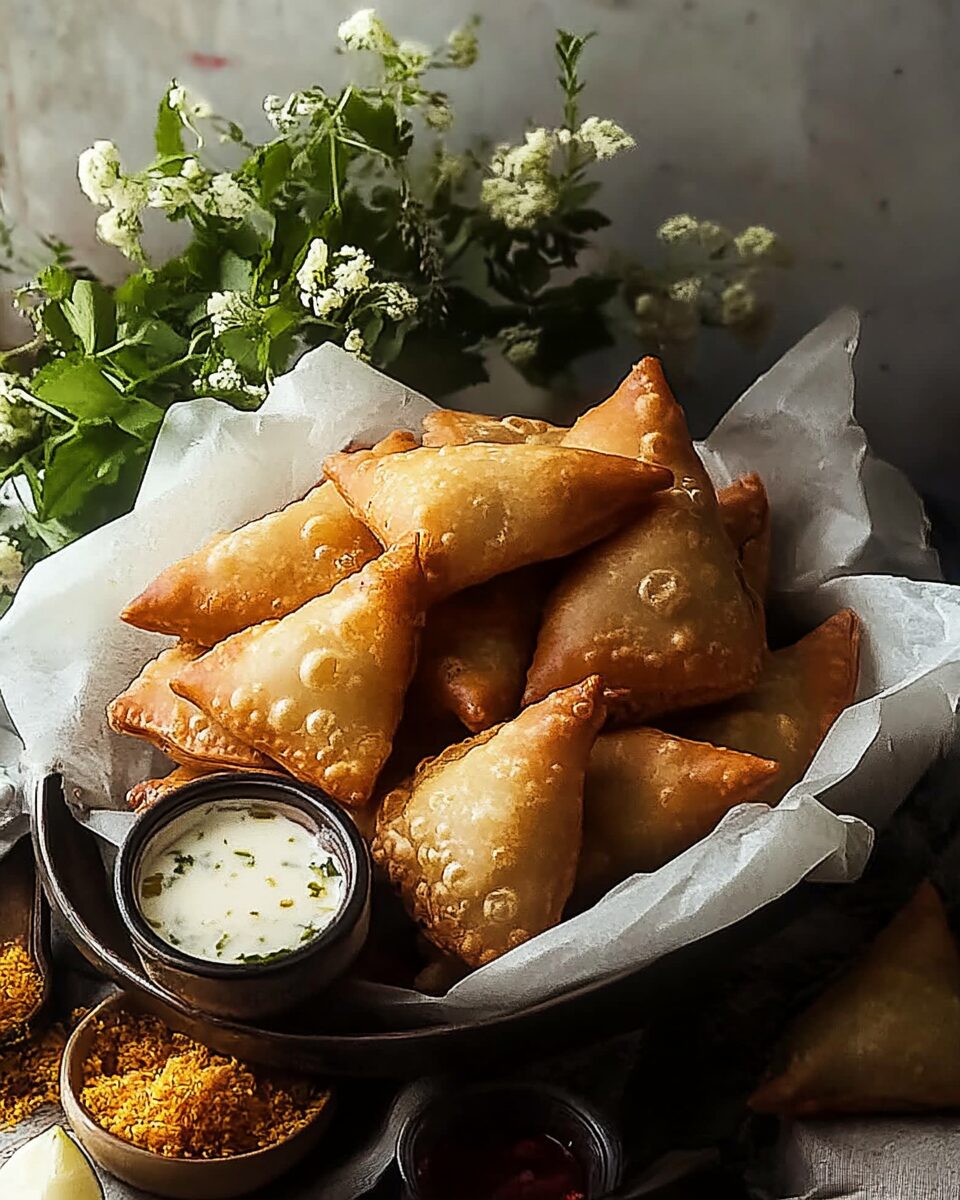Samosas are a beloved street food snack in India, known for their crispy golden exterior and spicy, flavorful filling. This version features a delicious blend of potatoes and peas, spiced to perfection with cumin, garam masala, and fresh green chilies. Each bite is a perfect combination of crunchy pastry and soft, aromatic filling, making it an irresistible snack for any time of day.
These samosas are easy to prepare and incredibly versatile. Serve them with your favorite chutneys or sauces for a burst of extra flavor. Whether you’re hosting a party or just craving a savory treat, these spiced potato and pea samosas are sure to be a hit with everyone!
Full Recipe:
- 2 tablespoons oil
- 1 teaspoon cumin seeds
- 1 small onion, finely chopped
- 2 teaspoons minced garlic
- 1 teaspoon minced ginger
- 2 green chilies, finely chopped
- 2 medium potatoes, peeled and diced
- 1 cup green peas (frozen or fresh)
- 1 teaspoon ground coriander
- 1/2 teaspoon garam masala
- 1/2 teaspoon turmeric powder
- Salt to taste
- 1 tablespoon lemon juice
- 1/4 cup fresh cilantro, chopped
- 1 package of store-bought samosa pastry or homemade dough
Directions:
- Heat oil in a pan over medium heat. Add cumin seeds and let them sizzle for a few seconds until aromatic.
- Add the finely chopped onion, garlic, ginger, and green chilies. Sauté until the onions are soft and golden brown.
- Stir in the diced potatoes, green peas, ground coriander, garam masala, turmeric powder, and salt. Mix well and cook on medium heat until the potatoes are soft and cooked through (about 10 minutes).
- Remove from heat, stir in lemon juice and fresh cilantro. Let the filling cool completely.
- Take the samosa pastry (or prepared dough) and cut it into rectangular strips.
- Fold each strip into a cone shape, fill with the potato and pea mixture, and seal the edges using a little water.
- Heat oil in a deep pan for frying. Once hot, carefully drop the samosas into the oil and fry until they turn crispy and golden brown.
- Drain on paper towels and serve with chutney or sauce of your choice.
Prep Time: 20 minutes | Cooking Time: 30 minutes | Total Time: 50 minutes
Kcal: 220 kcal (per serving) | Servings: 4-6
Spiced Potato and Pea Samosas: A Timeless Delight
Samosas are one of the most beloved snacks worldwide, with roots that trace back to ancient times. Originating in the Middle East before making their way to India, samosas have become synonymous with Indian street food culture. These savory pastries have a crispy golden exterior, filled with a spiced blend of potatoes and peas, and are enjoyed by people of all ages, across all walks of life.
In this article, we dive deeper into the world of samosas, exploring their history, significance in various cultures, regional variations, and the health aspects of enjoying this delicious snack.
A Brief History of Samosas
While today samosas are most commonly associated with Indian cuisine, their history spans much further back. The original version of the samosa, known as “sambosa,” is believed to have originated in the Middle East, particularly in Iran. It was a staple in the royal courts, enjoyed by nobility and commoners alike, and typically filled with meats such as minced lamb or beef, along with nuts and spices.
Samosas eventually made their way to India during the Delhi Sultanate era in the 13th century, brought by traders and travelers. Indian cooks adapted the recipe by introducing local spices and vegetarian fillings, which were more common in the Indian diet. Over time, samosas became a popular street food, loved for their simplicity, affordability, and rich, flavorful fillings.
Cultural Significance of Samosas in India
In India, samosas are much more than just a snack – they’re a cultural icon. From busy street markets to family gatherings and festivals, samosas are a must-have treat. They’re often served with tangy tamarind chutney, fresh mint chutney, or spicy green chutney, which complement the savory filling perfectly.
Samosas hold a special place during festivities such as Diwali and Ramadan. During these occasions, families come together to prepare and enjoy homemade samosas, making the dish an integral part of the celebration. They are also commonly served at weddings, birthdays, and other special events.
Even though samosas are deep-fried and indulgent, their significance goes beyond mere taste. They symbolize hospitality, comfort, and a sense of togetherness, as they are often shared among friends and family.
Why Spiced Potato and Pea Filling?
The potato and pea filling is perhaps the most popular and iconic variation of the samosa in India. There are several reasons why this particular filling stands out:
- Cost-Effective and Readily Available Ingredients: Potatoes and peas are staple ingredients in Indian households. They are affordable, accessible, and can be stored for long periods, making them ideal for making large batches of samosas.
- Versatility: The mild flavors of potatoes and peas serve as a perfect canvas for the bold spices used in Indian cooking. Ingredients like cumin seeds, garam masala, turmeric, and coriander add layers of flavor, transforming the simple potato and pea mixture into a complex and delicious filling.
- Vegetarian-Friendly: In a country where many people follow vegetarian diets, especially for religious reasons, a filling made from potatoes and peas provides a satisfying, hearty option that doesn’t rely on meat. It caters to a wide audience and has become the go-to filling for many samosa lovers.
- Perfect Texture Contrast: The soft, melt-in-your-mouth texture of the potato contrasts beautifully with the crispy, flaky pastry. The peas add a bit of sweetness and texture, ensuring that every bite is a burst of flavor.
Regional Variations of Samosas
While the potato and pea filling is perhaps the most famous, samosas are incredibly versatile, and different regions across India (and the world) have put their own spin on this beloved snack. Here are some notable regional variations:
- Punjabi Samosas: The most popular version is from the northern region of Punjab, where the samosa is typically larger and packed with a spicier potato filling. Sometimes, these samosas also contain paneer (Indian cottage cheese) or nuts, adding richness and creaminess to the filling.
- Bengali Shingara: In West Bengal, samosas are called “shingara.” While the basic ingredients remain the same, Bengali shingaras often include seasonal vegetables like cauliflower, green beans, and carrots, giving them a unique and flavorful twist.
- South Indian Samosas: In South India, samosas have a thinner and crispier crust, often filled with a mix of lentils, onions, and curry leaves. These samosas tend to be smaller in size and have a distinct flavor profile compared to their northern counterparts.
- International Adaptations: As samosas traveled across borders, they adapted to local tastes. In East Africa, samosas are often filled with spiced minced meat and are a popular street food in countries like Kenya and Tanzania. In Portugal and Brazil, a similar snack known as “pastéis” or “empadas” is filled with meats, seafood, or cheeses.
Cooking Techniques and Tips for the Perfect Samosa
Achieving the perfect samosa requires some attention to detail and a few key techniques:
- Pastry: Whether you’re using store-bought pastry or making your own, the dough needs to be rolled thin but sturdy enough to hold the filling. Homemade dough is typically made from all-purpose flour, oil, and water, kneaded into a smooth dough, and rested before rolling.
- Sealing: Proper sealing of the samosa is essential to prevent the filling from spilling out during frying. A paste made from flour and water works as an effective glue for sealing the edges of the samosa.
- Frying: Samosas should be fried on medium heat to ensure they cook evenly and become crispy. Frying them at a high temperature can result in the exterior becoming too dark while the inside remains undercooked. Fry them in batches and avoid overcrowding the pan to achieve the perfect texture.
- Baking Option: For a healthier alternative, you can bake samosas instead of frying them. Brush them with a light coating of oil and bake them in a preheated oven at 375°F (190°C) for 30-35 minutes, or until golden brown and crispy.
Pairing and Serving Suggestions
Samosas are typically served with a variety of condiments and chutneys that enhance their flavor. Here are some popular options:
- Tamarind Chutney: This sweet and tangy chutney balances out the spiciness of the filling and adds a refreshing burst of flavor to the samosa.
- Mint Chutney: Made from fresh mint, cilantro, green chilies, and lime juice, this chutney provides a cooling contrast to the rich, savory filling.
- Yogurt Dip: A simple yogurt-based dip mixed with a little salt and cumin can be a mild, creamy accompaniment for samosas, especially if you want to tone down the spice.
- Chili Sauce: For those who enjoy extra heat, pairing samosas with a spicy chili sauce or even a hot sauce adds an exciting fiery kick to the experience.
Health Considerations
While samosas are undeniably delicious, it’s important to be mindful of their nutritional content. Samosas are typically deep-fried, which means they can be high in calories and fat. However, there are ways to enjoy samosas in a healthier manner:
- Baking vs. Frying: Baking samosas significantly reduces the calorie and fat content without sacrificing flavor. The texture might be slightly different, but they will still have that delightful crunch.
- Air Fryer: Another option is using an air fryer, which mimics the crispiness of deep frying with very little oil. This method is becoming increasingly popular for making healthier versions of fried foods.
- Portion Control: Samosas are indulgent, so it’s best to enjoy them in moderation. They’re often served as a snack or appetizer, so pairing them with a light salad or soup can balance the meal.
Conclusion
Samosas, especially the spiced potato and pea variety, are more than just a snack – they’re a cultural symbol, a nostalgic treat, and a culinary adventure all wrapped into one. Whether you’re enjoying them fresh off the street in India or making them at home for a party, samosas never fail to bring joy with their crispy exterior and flavorful filling.
With regional variations, cooking techniques that cater to different diets, and endless pairing options, samosas have something for everyone. As you experiment with this timeless recipe, don’t be afraid to put your own twist on it. Whether you stick to the classic potato and pea filling or try out new combinations of spices and vegetables, samosas will continue to be a cherished part of global cuisine for generations to come.






